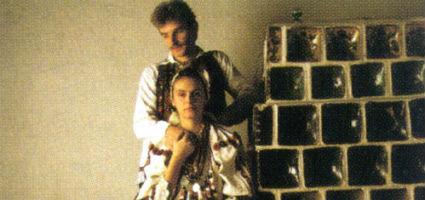The reconstructed house interior from the Ormánság is shown in the upstairs exhibition rooms. The old piling house made of wooden structure had doors opening to the backyard.
The kitchen was heated with an oven. The housewife cooked on the ember in front of the oven. The smoke left the house through the open door. A copper cauldron called "bogrács" hung over the fire. The ember was pulled out with a "kurugla". The pottery cooking pot was positioned on a three-legged stand. The so-called "tüzikutya", the translation is fire dog, had gaps for the skewer on which bread, bacon or meat was skewed. The most important tools used in the kitchen were hung around the walls, such were the cooking pot, colander, water jugs, pottery jug to age vinegar, saltcellar etc.
The flower and bird ornamented tile covered oven was made by the village potters. Cloths were hung over the oven on a rod. Small children slept on a bench in the corner behind the oven.
The wooden painted bed with bedclothes piled high up was situated in the other corner. Babies slept in shells placed on bench with turnable handles. The "szökröny", a small chest for cloths was at the end of the bed.
The table with a corner bench and carved chairs was positioned across the bed. Some ornamented plates hung on the walls over the table.
The Bible and a few indispensable things like soap, calendar etc. were kept on the balk.
Tools, various articles for use, agricultural equipment, chests, pottery and pieces of the loom were all stored in the chamber.


